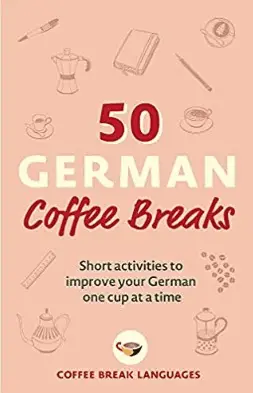After weeks of trudging through Im Krebsgang by Günter Grass, I was pleasantly surprised to receive a simple trade-off in my inbox: Would I review a copy of the recent book 50 Coffee Breaks in my preferred language? As a glutton for language resources and looking for a brief change from my current German practice, I agreed wholeheartedly to check out this collection of German coffee breaks.
A collaboration between the Teach Yourself series and the Coffee Break languages program, I was curious to see what this book was all about. After all, the whole premise of coffee break podcasts is that language learners can absorb information in brief, 15-minute sessions. And I’ve had good experiences with the Teach Yourself brand over the years—particularly with their Hindi course.
Before we start: My German Background
German is probably the language I know the best, but I still classify myself as an intermediate learner.
I began self-studying German in 2009 after a brief stay with a family in Kaiserslautern. The fact is, I fell head over heels for the language, but I wasn’t very structured. I tested into intermediate German when I started college two years later. Unlike all my other languages, I could speak German fairly decently—but my grammar was horrendous.
Over the years, I’ve continued to study the language. I’ve tried my hand at translation, spend a semester in Marburg, and read in the language on and off. I still struggle with some jokes and technical vocabulary, which is why I tend to rate my language skills as around B1.2 rather than the B2 it was in college. Granted, I can watch most movies without subtitles, read without looking up every word in the dictionary, and have basic conversations, so I feel pretty good about my level.
So, what does this have to do with Coffee Break German?
Based on my experience with the language, I feel like I can give a pretty balanced view of its explanations, language level, and general structure.
Coffee break lessons methodology

The entire layout of Coffee Break courses is that successful language learners show up regularly—and what’s more regular than a 5-to-15 minute coffee break? The book of 50 lessons is broken up into three sections: Activities for 5-minutes, 10-minutes, and 15-minutes. These tasks include:
- Translations
- Idiom challenges
- Quotations
- Recipes
- Picture descriptions
- Anagrams
According to the Coffee Break team, these activities are meant to help learners boost language skills like:
- Reading comprehension
- Writing skills
- Grammar confidence
- Translation abilities
- Vocabulary expansion
- Cultural awareness
What I loved
Let me be honest—I’m a workaholic. Between working and my share of household chores, mustering the time and energy for extended language sessions is difficult. Especially because I’m surrounded by multiple languages—and none of them are currently German.
So the first thing I loved about this series? It’s geared towards people who don’t have a lot of time.
Secondly, I really liked the exercise selection. In particular, the translation and writing exercises. I think they would be extremely beneficial to general vocabulary expansion.
The idiom challenges were helpful, especially because I don’t use that many idioms. Some of them I knew beforehand, but I think they do a good job of showing how the idioms are really used. These mini-lessons also double as a good grammar review, without getting overly technical.
I also found the general explanations to be clear and concise, making it a breeze for anyone with elementary German grammar knowledge to absorb the information with ease.
What I would have liked to see
No audio!
I find audio to be extremely beneficial with a new language because it becomes difficult to speak without proper listening comprehension. However, I am aware that there is a Coffee Break podcast, and more than one Coffee Break German season with specialized vocabulary and grammar lessons. Those who want more can look at the back of the book and match each lesson with a podcast episode on the same topic.
Personally, I also don’t like going all the way to the back of the book or section to review my answers, especially for an ebook. While this is pretty normal for language books, it becomes a bit of a hassle and easy to lose place. Having the answers after the mediate lesson would make it easier to check work without forgetting things, especially for learners who prefer to speak their answers rather than write them down (like me).
Otherwise, I didn’t really see any downsides, especially due to the targeted language learner level.
Which language learners would benefit from Coffee Break German?
Overall, the book was a bit below my level. I definitely knew all of the 5-minute exercises. There was a few new words or phrases in the 10-minute and 15-minute sections, but not enough for upper-intermediate learners.
I would say this series is more geared to serious learners of German rather than dabblers. While the 5-minute exercises are quite easy and elementary, the later Coffee Break lessons can be a bit more advanced for a dabbler with basic knowledge of the language.
Beginners and lower intermediate learners will get the most out of this book series, generally at the A2 or at the end of the A2 level.
Is 50 Coffee Breaks worth the price?
The big stickler here—out of all the language resources out there, including comprehensive textbooks—is 50 Coffee Breaks German worth it?
The ebook is listed at $5.99, and the paperback is $14.99.
Unless you hate ebooks, I think that the cost of the ebook is more appropriate. Like any language tool, you will outgrow the book at some point. While you can squeeze a few insightful lesson notes out of the book, it’s not necessarily a reference book you will turn to over and over again. The length and content of the reading exercises aren’t so memorable as to hold onto them.
In other words, this is a fun book, but it’s a light supplement. As a result, the ebook price closer matches the long-term value.
What languages are available in the 50 Coffee Breaks series?
The Coffee Break series focuses on core European languages. The following books are available now:
Other wunderbar German books
- Short Stories German by Olly Richards – Great for organically learning vocabulary and improving reading comprehension. Great for A2 beginners and above.
- German Grammar Drills – I used this grammar drills series back when I first started learning German. They are super helpful and a great supplement for free resources.
- English Grammar for Students of German – To be honest, I sucked at grammar when I first started learning languages. I didn’t get the case system at all. This book did more for me than any other language textbook.
- PONS Beginner Course German – As I mentioned, I started learning German because I lived with a family in the Rhineland. I didn’t want to wait until I returned home to find a textbook, so I got a PONS coursebook while in Germany. In my opinion, German textbooks are the bomb. They are affordable and comprehensive compared to their US counterparts.
- The Dictionary of German Synonyms – For intermediate and upper-intermediate learners, this is an essential book to expand your vocabulary and use the right word and the right time!



